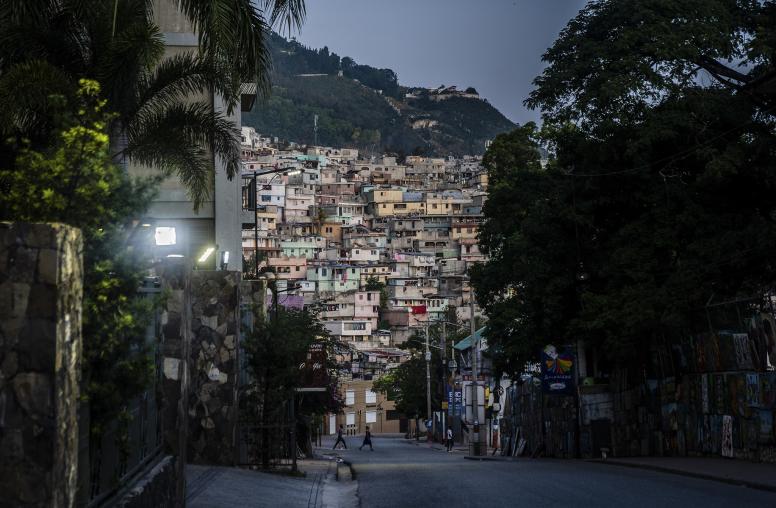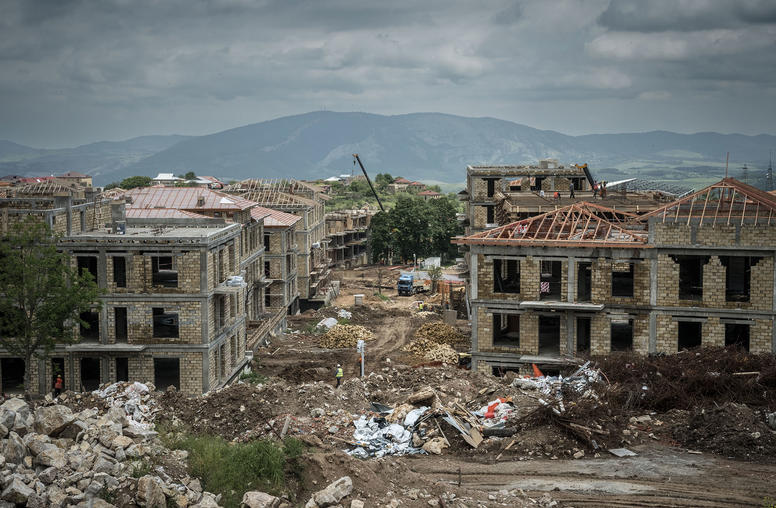 Colombia
Colombia
Since its founding over 20 years ago, USIP’s Colombia program has been one the Institute’s most strategic and impactful. USIP's experts contribute directly to some of the country’s most crucial efforts to mitigate and resolve the world’s longest-running internal armed conflict.
Despite the importance of the 2016 peace accord with the former FARC rebels, Colombia continues to struggle with an ongoing war with five remaining armed groups that collectively have more than 15,000 members and are causing a humanitarian crisis in over a quarter of the country’s municipalities. USIP’s comprehensive and focused response is divided into three strategic pillars:
1. Peace Process Support
The Institute provides direct support to four ongoing peace negotiations with different armed groups. This entails technical assistance and advice to government negotiations as well as timely expert convenings to generate ideas and feedback. Topics have included public participation design, cease-fire protocols, agenda development, confidence-building measures and synergies with implementation of the 2016 FARC Peace Accord.
Additionally, USIP has convened and facilitated dozens of public engagement sessions with strategic stakeholders, including leaders from community, think tank, media and business sectors. These outreach efforts have also generated communication tools and facilitated formal public participation and consultation mechanisms in several processes.
Moreover, USIP has regularly brought together key community leaders from cease-fire zones around the country for confidential qualitative evaluations of ceasefire monitoring mechanisms. Furthermore, the Institute has facilitated a series of coordination and lessons-learned workshops between the government negotiations teams with the support of the U.N. Verification Mission in Colombia
Furthermore, the Institute has provided direct financial and technical backing to the Catholic Church’s special envoys in the peace processes, as well as facilitated interreligious forums to strengthen the voice of moral authority of religious leaders in positively influencing peace negotiations.
USIP has also supported civil society and government efforts to improve initiatives to strengthen the participation of women’s organizations and female negotiators as well as prevent the recruitment of youth into armed groups in coordination with Colombia’s vice president.
The Institute has also engaged extensively in research efforts related to the nexus between peace negotiations and environmental challenges, such as deforestation, in the lead up to Colombia’s hosting of the COP16 U.N. Global Conference on Biodiversity.
Finally, USIP has supported community engagement in initiatives to remove landmines in the southwestern department of Nariño and social dialogue among communities trapped across conflict divides in Bolívar, Arauca and Chocó.
2. Security Sector Reform
The Institute provides expert advice and facilitates processes related to ongoing civil society- and government-led efforts to revamp paradigms among the country’s robust security agencies contributing core peacebuilding approaches.
At the request of the Ministry of Defense, USIP supports the implementation of the Colombian Truth Commission’s recommendations to guarantee non-repetition of past abuses attributed to security services. This has included spearheading an internal awareness-raising campaign for the police and military throughout the country on the commission’s findings and the ongoing efforts to improve their legitimacy with citizens of diverse backgrounds.
Furthermore, the Institute has funded and facilitated dialogue processes between leaders of stigmatized communities and the security forces — including a nearly two-year long process between youth protesters and police in the city of Cali in the aftermath of the 2021 social unrest. USIP also supports the rollout of a new model of policing that seeks to guarantee a service more oriented toward concerns prioritized by communities.
Moreover, the Institute works with the leadership of the Colombian Congress’ Intelligence Oversight Committee to strengthen technical knowledge, build constructive relationships with the primary four intelligence agencies, and foster understanding on how implicit bias and citizen stigmatization can undermine the objectivity of analysis.
USIP also provides direct technical assistance to the Minister of Defense’s advisors on how to build synergies between the current security policy’s community protection imperatives and cease-fire protocols which suspend unilateral operations with several armed groups.
Similarly, the program has contributed extensively to the preparation of the security forces’ role in multiple cease-fire and de-escalation mechanisms. The Institute is the primary external partner of the police’s peacebuilding unit (UNIPEP), the only national specialized unit dedicated to accompanying peace processes in the world.
3. Transitional Justice
In backing the implementation of the 2016 FARC Peace Accord, the Institute directly supports the country’s groundbreaking transitional justice court, the Special Jurisdiction for Peace (JEP), which tries perpetrators of war crimes in adherence to International Criminal Court standards.
This has included direct technical assistance and advice in the development of the JEP’s manual for restorative justice, which has become a global reference document. Additionally, the Institute and JEP have jointly convened two international multi-day public conferences on the integration of restorative and punitive practices.
Additionally, the Institute has consolidated proposals for further strengthening the JEP’s procedures and functioning, as well as conducted extensive training for magistrates and staff on the core principles of reconciliation.
Furthermore, USIP has provided similar certificate courses for those deemed responsible for war crimes who have committed to the JEP’s requirements of exhaustive truth-telling and displays of contrition to victims. The Institute also helps communities develop concrete ideas for environmental reparations when the JEP recognizes specific ecosystems as victims of the war.
The Institute leads a private working group with some of the country’s premier judicial experts to foster consensus around key precepts and precedents in the building of new transitional justice frameworks or collective plea-bargaining arrangements for current armed groups. Similarly, these efforts have included preparing victims for direct participation in current peace negotiations processes.
Finally, USIP accompanies victims of some of the war’s most egregious atrocities to engage with perpetrators in symbolic ceremonies to commemorate anniversaries, consolidate truth, and contribute to healing deep psychological and social wounds.
Learn more in USIP’s fact sheets on our work in Colombia, available in English and Spanish.
Featured Research & Analysis

Steve Hege on Restorative Justice and Colombia’s Search for Missing Persons
More than 100,000 Colombians have been forcibly disappeared over the last six decades. Finding their remains is “tremendously healing” and can “repair the social fabric” by giving closure to the victims’ loved ones and allowing former armed actors “to regain their own dignity” by contributing to the process, says USIP’s Steve Hege.

Cartographie du chemin de la justice en Haïti : Leçons de la Colombie et du Guatemala
Le nouveau gouvernement intérimaire d'Haïti fait face à des défis immenses, mais aucun n'est aussi urgent que de briser l'emprise des gangs sur la capitale du pays, Port-au-Prince. La force seule ne suffira pas à apporter la paix, même avec l'arrivée de la mission multinationale de soutien à la sécurité dirigée par le Kenya, de taille modeste. Le pays a plutôt besoin de mécanismes créatifs et globaux impliquant toute la société — et non seulement l'ensemble du gouvernement — pour détourner les membres des gangs du crime et de la violence dans le cadre d'une stratégie globale de lutte contre les gangs.

Mapping Haiti’s Road Toward Justice: Lessons from Colombia and Guatemala
Haiti’s new interim government faces immense challenges, but none are as urgent as breaking the stranglehold that gangs have over the country’s capital, Port au Prince. Force alone will not bring peace, even with the arrival of the modestly-sized and Kenyan-led multinational security support mission. The country instead requires creative, whole-of-society — not just whole-of-government — mechanisms to divert gang members from crime and violence as part of a comprehensive counter-gang strategy.
Current Projects

Generation Change Fellows Program
Generation Change works with young leaders across the globe to foster collaboration, build resilience and strengthen capacity as they transform local communities.

Peacemaking in a Turbulent World: Lessons from Intrastate and Interstate Conflicts
Peacemaking in a Turbulent World answers the following central question: What lessons for effective management of intrastate conflicts emerged from the post-Cold War period that are relevant for managing contemporary conflicts which include intrastate, internationalized (featuring direct engagement by outside powers), and interstate conflicts?

Youth Advisory Council
Built upon the belief that youth bring significant and unique insight to peacebuilding, the U.S. Institute of Peace’s Youth Advisory Council (YAC) provides a mechanism through which USIP experts can benefit from youth perspectives and expertise. The YAC enables USIP staff to engage youth as partners, experts, and practioners while elevating youth voices and experience to the international level. The YAC contributes to USIP’s vision for an inclusive approach to peacebuilding. The Youth Advisory Council meets regularly to bring together youth thought leaders and peacebuilding experts committed to the Institute’s mission and activities.